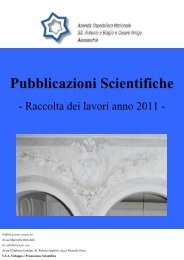Working Paper of Public Health Volume 2012 - Azienda Ospedaliera ...
Working Paper of Public Health Volume 2012 - Azienda Ospedaliera ...
Working Paper of Public Health Volume 2012 - Azienda Ospedaliera ...
Create successful ePaper yourself
Turn your PDF publications into a flip-book with our unique Google optimized e-Paper software.
<strong>Azienda</strong> <strong>Ospedaliera</strong> Nazionale“SS. Antonio e Biagio e Cesare Arrigo”<strong>Working</strong> <strong>Paper</strong> <strong>of</strong> <strong>Public</strong> <strong>Health</strong>nr. 7/<strong>2012</strong>that women who were currently using combined oral contraceptives (containing anestrogen and a progestogen) or who had used them in the past 10 years, they have aslightly higher risk <strong>of</strong> having breast cancer diagnosed. In particular, some: “Experimentaldata suggest that conventional estrogen treatment regimens, both as oral contraceptives(OCs) and hormone therapy (HT). . ., upset the normal estrogen/androgen balance andpromote ‘unopposed’ estrogenic stimulation <strong>of</strong> mammary epithelial proliferation and,hence, potentially breast cancer risk” (Dimitrakakis and Bondy, 2009, original emphasis).Barnes et al. (2011) argue that hormone therapy has the highest “population attributablerisks . . . . <strong>of</strong> 19.4%” for overall invasive tumors (p. 345). Other research shows differentresults: OCs are not associated to an increased risk <strong>of</strong> breast cancer (cf. Rosenblatt et.al.2009, p. 32). Although several changes in doses and biochemical structures have takenplace over time, there is a hot scientific debate about the possibility that oralcontraceptives (OCs) may increase the risk <strong>of</strong> breast cancer (Brinton et al., 1997;Marchbanks et al., 2002; Marchbanks et al., 2011). Industrialization has also driven amodernization <strong>of</strong> societies, improving the role <strong>of</strong> women and the introduction <strong>of</strong> the OCshas had a high impact in terms <strong>of</strong> social life, careers <strong>of</strong> woman, fertility control, genderrelations, feminist movement and sexual approaches. Botha et al. (2003) find higher rate<strong>of</strong> breast cancer into well-developed countries <strong>of</strong> Northern and Western Europe that arethe first to receive the fruitful effects <strong>of</strong> industrialization and modernization in terms <strong>of</strong>widespread wellbeing and also some health concerns. They also argue that in thesecountries the main risk factors are: “use <strong>of</strong> hormonal contraception and replacementtherapy, changes in menstrual history and obesity” (Botha et al., 2003, p. 1727). Inaddition, they confirm an increasing time trends in breast cancer incidence. Theincreasing role <strong>of</strong> women in advanced societies is showed not only with the use <strong>of</strong> OCs,but also with other socio-economic behaviors that are main cancer risk factors such assmoking, alcohol, etc. (Brinton et al., 1996p. 201). Regan (2010), studying Swedencontext, shows that the effect <strong>of</strong> culture, historical factors, women’s level <strong>of</strong> literacy andreligious composition are economically significant determinants <strong>of</strong> demand for the oralcontraceptive pill. As far as the research on global breast cancer seasonality by Oh et al.(2010) is concerned, these authors find that breast cancer increases as the latitude <strong>of</strong>population residence increases (i.e. distance from equator increases) and “suggestbiologic rather than social root causes” This interesting result can be explained by analternative socio-economic interpretation represented by the distribution <strong>of</strong> richer15


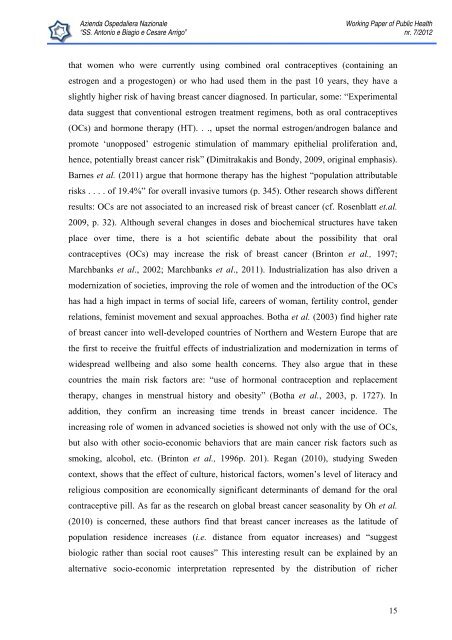
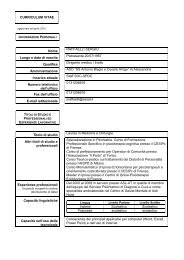
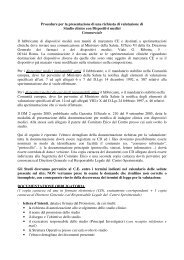

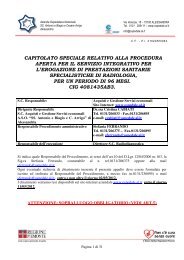
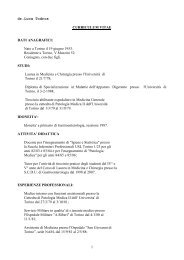


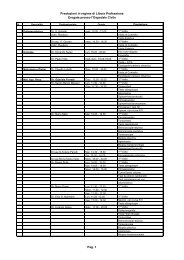


![[torino - 1] lastampa/urc/01 ... 26/10/09 - Azienda ...](https://img.yumpu.com/44058002/1/190x32/torino-1-lastampa-urc-01-26-10-09-azienda-.jpg?quality=85)

